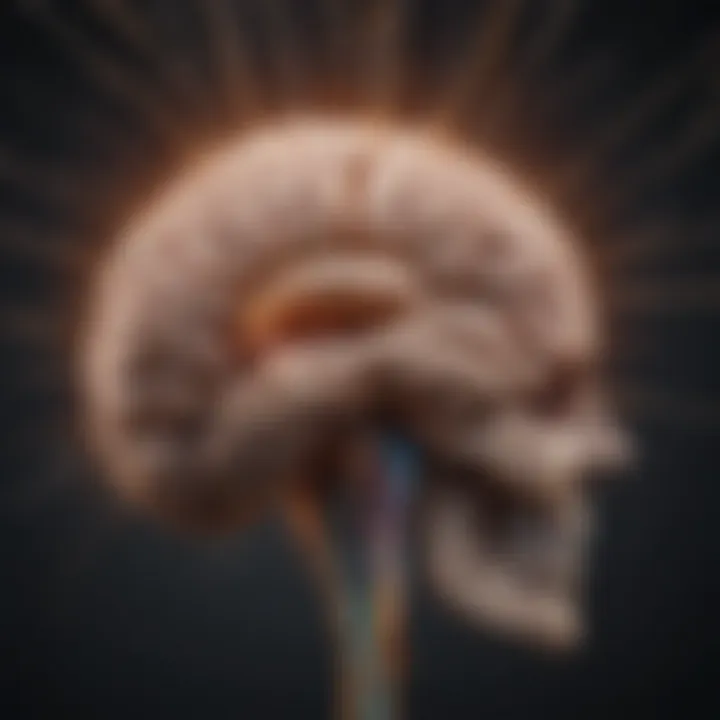Exploring Brain Inflammation: Mechanisms and Impacts


Intro
Inflammation in the brain represents a significant area of study that encompasses numerous complexities and implications. This phenomenon occurs when the body’s immune system responds to injury or infection. It is crucial to comprehend this response, as neuroinflammation may play a vital role in various neurological disorders.
Understanding the mechanics behind inflammation in the brain paves the way for insightful discussions on how it connects to conditions such as Alzheimer’s Disease and multiple sclerosis. Furthermore, examining this connection is not only essential for neuroscientific research but also for the advancement of therapeutic strategies aimed at improving patient outcomes.
Article Overview
Purpose of the Article
This article aims to elucidate the multifaceted nature of brain inflammation, detailing its definitions, causes, and mechanisms. By delving deeply into neuroinflammation, the article seeks to bridge gaps in current understanding and highlight its implications for neurological conditions. This exploration will also aim to present a clear picture of ongoing research efforts focused on management and treatment modalities.
Relevance to Multiple Disciplines
The implications of understanding inflammation extend beyond neuroscience. This topic is relevant to numerous fields, including:
- Medicine: Insights into brain inflammation can guide therapeutic strategies.
- Psychiatry: The connection between inflammation and mental health disorders has garnered attention.
- Pharmacology: Understanding mechanisms may lead to the development of targeted drugs.
- Public Health: Knowledge on this topic can inform preventive health measures.
Research Background
Historical Context
The study of inflammation has its roots in early medical research. Over time, it has grown to encompass various systems, with a distinct focus on the brain in recent decades. Initially seen as a localized response, contemporary research illuminates the broader implications of neuroinflammation, particularly concerning chronic conditions. Early investigations laid the groundwork for contemporary studies focusing on the role of the immune system in neurological health.
Key Concepts and Definitions
Before delving further, it is important to establish some key concepts:
- Neuroinflammation: This refers to the inflammation of nervous tissue. It can occur due to infection, injury, or disease.
- Cytokines: These are signaling molecules that mediate and regulate immunity and inflammation.
- Microglia: The primary immune cells of the central nervous system, playing a key role in responding to injury or disease.
Understanding these concepts is essential for grasping the significance of inflammation in the brain and its potential impact on health.
"Neuroinflammation is not merely a symptom but rather a central player in many neurological disorders."
"Neuroinflammation is not merely a symptom but rather a central player in many neurological disorders."
Defining Brain Inflammation
Brain inflammation, or neuroinflammation, plays a critical role in the functioning of the central nervous system. It can signify both a protective response and a pathological condition. Understanding this duality is essential for grasping the broader implications of inflammation on brain health and its roles in various neurological disorders.
The brain operates under a unique physiological framework. Inflammation within this system often arises from a disruption, which can be indicative of underlying health issues. Therefore, accurately defining brain inflammation is imperative. It serves as a foundation for exploring treatment options, understanding pathology, and advancing research methodologies.
Moreover, inflammation is not merely a biological response; it encapsulates a series of biochemical pathways that affect brain homeostasis. Grasping the definitions and nuances of inflammation empowers researchers and clinicians to challenge existing paradigms, thus paving the way for innovative approaches to intervention.
What Constitutes Inflammation?
Inflammation is characterized by a complex biological response of tissues to harmful stimuli. This response includes pathogens, damaged cells, or irritants. The various components involve:
- Redness and heat: These arise from increased blood flow to the affected site due to vascular dilation.
- Swelling: This results from the accumulation of fluid and immune cells in the tissues.
- Pain: This occurs due to the release of inflammatory mediators that sensitize nerve endings.
In the brain, this cascade can lead to both protective mechanisms, such as isolation of pathogens, and detrimental effects, like neuronal damage. It is important to note that inflammation can also manifest on a cellular level, involving various signaling molecules, including cytokines and chemokines.
Types of Inflammation in the Central Nervous System
Neuroinflammation can be classified into several types based on its origin and progression:
- Acute inflammation: Typically a short-lived response that occurs following an injury or infection. It is meant to eliminate the initial cause of injury and initiate healing.
- Chronic inflammation: This occurs when the inflammatory response persists over time, often due to ongoing injury or a failure to completely eradicate the initial issue. Chronic neuroinflammation is associated with various neurodegenerative conditions.
- Focal vs. diffuse inflammation: Focal inflammation is localized to a specific area of the brain, whereas diffuse inflammation spreads across larger regions, affecting broader neural functions.
Each type of inflammation carries distinct implications for brain health. Understanding them allows researchers to identify which pathways are activated during specific pathology, and how to approach treatment effectively.
Acute vs. Chronic Inflammation
Acute and chronic inflammation represent two ends of a spectrum of immune responses.


- Acute inflammation is generally beneficial. It triggers healing processes and protects against infections. However, if unresolved, it can transition into chronic inflammation.
- Chronic inflammation, on the other hand, often leads to sustained tissue damage. This can precipitate a range of neurological disorders. Chronic inflammation in the brain correlates with diseases such as Alzheimer's and multiple sclerosis.
Recognizing the differences between these two forms is vital. Therapeutic strategies that target specific inflammatory pathways may need to be tailored according to the type of inflammation present. By distinguishing between acute and chronic forms, researchers can focus on suitable intervention methods for each scenario.
Mechanisms of Brain Inflammation
Brain inflammation, or neuroinflammation, involves complex interactions among various cell types and signaling pathways. Understanding these mechanisms is crucial for comprehending how inflammation contributes to neurological disorders and influences overall brain health. The brain’s unique environment means that this inflammation can have far-reaching effects on neuronal function and connectivity.
Cellular Players: Microglia and Astrocytes
Microglia and astrocytes are pivotal in the brain's inflammatory response.
Microglia function as the primary immune cells in the central nervous system. These cells monitor the brain’s microenvironment, identifying and responding to pathologies. When activated, microglia change shape, proliferate, and release cytokines that can either promote healing or exacerbate inflammation.
Astrocytes, another type of glial cell, provide structural support and nutrients to neurons. They also play a role in the inflammatory process. Upon activation, astrocytes can release chemokines that influence the recruitment of immune cells.
The interaction between microglia and astrocytes is key in controlling inflammation. If these mechanisms become dysregulated, it can lead to chronic neuroinflammation, which is implicated in conditions like Alzheimer's Disease and multiple sclerosis.
Inflammatory Pathways: Cytokines and Chemokines
Cytokines and chemokines are central mediators of inflammation in the brain.
Cytokines are proteins that facilitate communication between cells during immune responses. Some cytokines promote inflammation (pro-inflammatory), such as tumor necrosis factor-alpha (TNF-alpha) and interleukins like IL-1 and IL-6. Conversely, other cytokines act to reduce inflammation (anti-inflammatory), helping to balance the immune response.
Chemokines are a specific category of cytokines, primarily responsible for the directional migration of immune cells. They guide cells to sites of inflammation, ensuring that the immune response is localized and effective. Overproduction of inflammatory cytokines and chemokines can lead to damage of brain tissues, contributing to neuronal death and neurological deficits.
Blood-Brain Barrier and Its Role
The blood-brain barrier is a selective permeability barrier that protects the brain from potentially harmful substances and pathogens in the bloodstream. It is formed by endothelial cells tightly joined together, which limits the passage of molecules.
However, during inflammation, this barrier can become compromised. Factors such as increased cytokine production can alter the integrity of the blood-brain barrier, allowing immune cells and inflammatory mediators to enter the brain. This disruption can further propagate neuroinflammation and lead to additional neuronal harm. Therefore, understanding the role of the blood-brain barrier is essential for developing targeted interventions to mitigate neuroinflammation and protect brain health.
The interplay between microglia, astrocytes, cytokines, and the blood-brain barrier illustrates the complexity of neuroinflammation and emphasizes the need for ongoing research in this area.
The interplay between microglia, astrocytes, cytokines, and the blood-brain barrier illustrates the complexity of neuroinflammation and emphasizes the need for ongoing research in this area.
By exploring these mechanisms, researchers can identify potential therapeutic targets to treat or even prevent neuroinflammatory-related disorders. Understanding the mechanisms of brain inflammation not only aids in pinpointing the underlying causes of various neurological conditions but also shapes future treatment paradigms.
Causes of Neuroinflammation
Neuroinflammation can arise from various sources, each contributing to the complexities of this condition. Understanding these causes is crucial for comprehending how inflammation affects brain health. Each cause is intertwined with different potential pathways, leading to various neurological disorders. By focusing on the origin of such inflammation, researchers seek to create effective interventions that could mitigate the effects. The significance lies in identifying the triggers that lead to persistent inflammation. This recognition is vital for early detection and preventive strategies in clinical settings.
Infectious Agents and Pathogens
Infectious agents are a major source of neuroinflammation. Pathogens, such as bacteria, viruses, and fungi, can invade the brain and trigger an inflammatory response. For example, the herpes simplex virus has been linked to increased inflammation in specific brain regions. When these agents infiltrate neural tissues, they provoke a defensive reaction from microglia and astrocytes, leading to the production of inflammatory cytokines.
Some noteworthy infectious diseases that directly impact the brain include:
- Neuroborreliosis: Caused by Borrelia spirochetes. It leads to significant cognitive impairment and mood disorders.
- Neurosyphilis: Associated with Treponema pallidum. This infection often results in serious neuroinflammatory responses.
- HIV and AIDS: The virus directly affects the immune system, resulting in chronic inflammation and neurodegeneration.
These infectious agents highlight the importance of maintaining a robust immune response. However, if the inflammation remains unresolved, it can lead to permanent damage and long-term neurological effects.
Autoimmune Reactions
Autoimmune reactions are another significant cause of neuroinflammation. In these cases, the body's immune system mistakenly targets its brain tissues, leading to inflammatory cascades. Diseases such as multiple sclerosis exemplify how autoimmune processes result in inflammation. In multiple sclerosis, the immune system attacks myelin, a protective sheath around neurons, causing a cascade of inflammatory responses that damage neuronal connections.
Possible autoimmune conditions contributing to neuroinflammation include:
- Systemic lupus erythematosus: This condition can cause neuropsychiatric symptoms due to brain inflammation.
- NMO (Neuromyelitis Optica): A severe condition that primarily targets the optic nerves and spinal cord.
These reactions can manifest in various forms, affecting cognitive function and overall wellbeing. Understanding autoimmunity’s role in neuroinflammation is essential for developing targeted therapies.
Environmental Factors and Toxins


Environmental factors and toxins are increasingly recognized as catalysts for neuroinflammation. Exposure to neurotoxic substances can provoke inflammatory responses, leading to long-term health implications. Among the common environmental toxins are heavy metals, pesticides, and industrial chemicals.
Some examples of how these toxins influence inflammation include:
- Lead exposure: Linked to cognitive decline and decreased IQ, particularly in children.
- Pesticides like organophosphates: Associated with neurodegenerative diseases.
- Air pollution: Recent studies indicate a correlation between particulate matter and increased neuroinflammation in older adults.
It's critical to consider both external pollutants and lifestyle factors in understanding neuroinflammation. The interaction between these elements can set off significant inflammatory pathways in the brain.
Understanding the root causes of neuroinflammation is vital in addressing its implications for health, particularly in neurological disorders. Chronic inflammation could potentially exacerbate cognitive decline.
Understanding the root causes of neuroinflammation is vital in addressing its implications for health, particularly in neurological disorders. Chronic inflammation could potentially exacerbate cognitive decline.
Neuroinflammation and Neurological Disorders
Neuroinflammation serves as a crucial link between the immune system and the central nervous system. Understanding the role it plays in neurological disorders is essential for developing effective treatments and interventions. The relationship between neuroinflammation and diseases like Alzheimer’s disease, multiple sclerosis, Parkinson’s disease, and traumatic brain injury reveals how inflammation affects brain function and structure. Each disorder presents unique characteristics and symptoms that underscore the complexity of neuroinflammation.
Alzheimer's Disease
Alzheimer's disease is characterized by a progressive decline in cognitive function. Neuroinflammation in this context is particularly significant. Studies show that the activation of microglia, the brain's immune cells, contributes to the pathogenesis of Alzheimer's. When these cells become chronically activated, they can release pro-inflammatory cytokines. This process exacerbates neurodegeneration and leads to synaptic dysfunction. A key consideration here is the amyloid-beta plaques found in Alzheimer’s patients. These plaques may trigger an inflammatory response, which can further damage healthy brain tissue. Understanding this connection opens pathways for potential therapeutic interventions, targeting inflammation to slow or halt the progression of the disease.
Multiple Sclerosis
Multiple sclerosis is an autoimmune disorder that disrupts communication between the brain and the body. Neuroinflammation is a central feature of this condition, where the immune system mistakenly targets myelin, the protective sheath surrounding nerve fibers. This attack causes inflammation and lesions in the central nervous system, leading to various neurological symptoms. Researchers emphasize that the interplay between inflammatory mediators and the damaged nervous system is complex. A better understanding may help in creating methods to modulate this immune response, potentially leading to more effective treatments. Research into specific cytokines, chemokines, and their roles in MS can illuminate new approaches for managing this debilitating condition.
Parkinson's Disease
Parkinson's disease is marked by motor system impairments and is closely associated with neuroinflammation. Evidence points to the activation of microglia in the brain regions affected by the disease, particularly the substantia nigra. Chronic inflammation in Parkinson's is believed to contribute to neuronal cell death. Studies have shown that alpha-synuclein, a protein that aggregates in Parkinson’s, influences glial cells to adopt a pro-inflammatory state. This inflammatory environment can aggravate neurodegeneration. Assessing the role of neuroinflammation in Parkinson’s is vital for developing future therapeutic strategies that could involve anti-inflammatory agents or techniques to reset the immune response.
Traumatic Brain Injury
Traumatic brain injury (TBI) produces immediate and long-lasting effects on brain function. Neuroinflammation following TBI is a significant concern. The injury initiates a cascade of inflammatory responses, which can lead to secondary injury days to weeks after the initial trauma. The release of inflammatory cytokines and the activation of microglia can contribute to cell death and worsen neurological outcomes. Recognizing the need for timely intervention is essential. Exploring treatments that can mitigate neuroinflammatory processes may improve recovery and long-term outcomes for TBI patients. Understanding this dynamic is fundamental for researchers and clinicians aiming to improve patient prognoses.
"Neuroinflammation is not just a byproduct of brain disorders; it is an active participant in their progression."
"Neuroinflammation is not just a byproduct of brain disorders; it is an active participant in their progression."
In summary, each neurological disorder shares a common thread through neuroinflammation. The complexities of these interactions present an ongoing challenge in the field of neuroscience. As research continues, better understanding of these mechanisms will enhance the capability to develop targeted therapies, allowing for more personalized treatment in the future.
Research Methodologies in Studying Brain Inflammation
Research methodologies are crucial in studying brain inflammation. They enable scientists to elucidate the intricate nature of neuroinflammation and its relation to various neurological disorders. In this context, understanding the different methodologies allows for better experimental design, more precise data collection, and improved therapeutic strategies. There are a variety of approaches used in this field, each serving unique purposes and providing distinct insights into how inflammation affects the brain.
Imaging Techniques
Imaging methods are essential tools in researching brain inflammation. Techniques such as magnetic resonance imaging (MRI) and positron emission tomography (PET) allow for non-invasive observation of the brain's structural and functional changes. MRI provides high-resolution images that can identify areas of inflammation. Meanwhile, PET can visualize metabolic processes and identify inflamed regions by tracking specific radiolabeled tracers.
These imaging modalities enhance our understanding of conditions like multiple sclerosis and Alzheimer’s disease, allowing researchers to correlate inflammation with clinical symptoms. They also offer a way to assess the efficacy of therapeutic interventions over time.
Biomarker Identification
Biomarkers play a vital role in the assessment of neuroinflammation. Identifying specific molecules in blood or cerebrospinal fluid can help track the presence and intensity of inflammation. Markers such as cytokines, chemokines, and other inflammatory mediators are critical in providing measurable indicators of the inflammatory process. The ability to detect these biomarkers can lead to quicker diagnoses and facilitate better-targeted treatments.
The advent of advanced technologies, like mass spectrometry and enzyme-linked immunosorbent assays (ELISA), has improved the specificity and sensitivity of biomarker detection. However, researchers must consider the variability in markers due to factors like environmental influences and disease states when designing studies.
Animal Models of Inflammation
Animal models are an indispensable part of researching brain inflammation. They allow scientists to manipulate variables and observe the resulting changes in vivo. Common models include rodents, which are often used to study specific inflammatory pathways and the resulting neurological impacts.
These models can mimic various human conditions, including traumatic brain injury and autoimmune disorders. By observing the progression of neuroinflammation in these controlled settings, researchers can identify potential therapeutic targets and evaluate the effectiveness of new treatments before moving to human trials. Nonetheless, ethical considerations of using animals in research must be carefully balanced with the potential benefits of developing effective therapies for humans.
Understanding the methodologies in brain inflammation research is key to advancing knowledge and treatment options.
Understanding the methodologies in brain inflammation research is key to advancing knowledge and treatment options.


The combination of these methodologies—imaging techniques, biomarker identification, and animal models—creates a comprehensive framework for understanding the complexities of neuroinflammation. Ultimately, these research approaches lay the groundwork for new discoveries in treating and managing neurological disorders.
Therapeutic Approaches to Neuroinflammation
Neuroinflammation has significant implications for brain health and various neurological disorders. Addressing this issue is vital, as therapeutic approaches can help in minimizing damage and improving patient outcomes. Various strategies are currently under investigation or implementation. These include anti-inflammatory medications, biologics, and lifestyle modifications. Each approach has its own potential benefits and considerations.
Anti-inflammatory Medications
Anti-inflammatory medications are often the first line of treatment for reducing neuroinflammation. These drugs work by targeting specific pathways involved in the inflammatory response. Commonly used medications include non-steroidal anti-inflammatory drugs (NSAIDs) like ibuprofen and naproxen. They can decrease neuroinflammation by inhibiting the production of cytokines.
Moreover, corticosteroids are another example that might be employed for acute flare-ups of inflammation. They are potent anti-inflammatories used to manage conditions such as multiple sclerosis. However, the long-term use of these drugs might lead to adverse effects. Patients should have thorough discussions regarding their risks and benefits.
"The choice of an anti-inflammatory medication should always take individual patient needs and conditions into account."
"The choice of an anti-inflammatory medication should always take individual patient needs and conditions into account."
Biologics and Their Mechanisms
Biologics represent a newer class of therapeutic agents. These drugs are derived from living organisms and target specific inflammatory processes. For instance, monoclonal antibodies can inhibit the action of inflammatory cytokines in the central nervous system. This specificity often results in fewer side effects compared to traditional medications.
Agents like Natalizumab and Ocrelizumab have shown promise in treating conditions such as multiple sclerosis. They block the movement of immune cells across the blood-brain barrier, reducing the inflammatory response. The development of biologics is paving the way for more personalized treatment options for individuals dealing with neuroinflammation.
Lifestyle Modifications and Their Impact
Lifestyle choices can significantly influence neuroinflammation. Evidence suggests that diets rich in omega-3 fatty acids may help reduce inflammation. Regular physical activity also appears to play a role in managing inflammatory processes in the brain.
Incorporating mindfulness practices, such as yoga and meditation, can reduce stress-related neuroinflammation. Furthermore, sleep quality is another important factor; disrupted sleep may exacerbate inflammatory responses.
Giving attention to these lifestyle modifications can provide supplementary benefits alongside pharmacological treatments. They can enhance quality of life and possibly slow the progression of neuroinflammatory disorders.
The Future of Research on Brain Inflammation
The field of brain inflammation research is evolving rapidly. Advances in technology, methodology, and understanding of neuroinflammation promise exciting new insights. As the link between brain inflammation and various neurological disorders becomes clearer, further investigation is not just beneficial; it is essential. Understanding inflammation in the brain has implications for treatment options, patient care, and neurological health on broader scale.
Emerging Trends and Technologies
In recent years, several trends have emerged in the study of brain inflammation. Technologies like advanced imaging techniques are now more widely used. For example, positron emission tomography (PET) is allowing researchers to observe inflammation in real time. Such imaging techniques provide valuable data about how inflammation correlates with disease progression or response to treatment.
Moreover, the rise of machine learning and artificial intelligence in analyzing complex datasets is reshaping research capabilities. These technologies can identify patterns that are not immediately apparent, which enhances understanding of the underlying mechanisms of neuroinflammation.
Potential for New Therapeutics
Research continues to demonstrate that understanding brain inflammation may give rise to new therapeutic strategies. For example, biologics that target specific inflammatory pathways are being developed. These therapies could offer patients more tailored treatment options, increasing the efficacy of interventions.
Additionally, the concept of neuroprotective agents is gaining traction. Such agents aim to not only reduce inflammation but also promote recovery in presently damaged neural tissues. With an increasing body of evidence, there is optimism regarding the development of these innovative therapeutic pathways.
Collaborative Research Efforts
Collaboration is fundamental for advancing research on brain inflammation. Multi-disciplinary partnerships among neuroscientists, immunologists, and clinicians enrich the investigative landscape. The convergence of expertise facilitates a comprehensive approach to understanding and managing inflammatory processes in the brain.
Public and private sector collaborations are also proving beneficial. Companies like Biogen and pharmaceutical giants are working closely with academic institutions to foster innovation. This synergy not only enhances research but can accelerate bringing new therapies from laboratory to clinic.
"The future of neuroinflammation research is likely to be driven by collaboration, leveraging technology, and integrating findings across disciplines."
"The future of neuroinflammation research is likely to be driven by collaboration, leveraging technology, and integrating findings across disciplines."
Together, these elements underline the ongoing importance of research on brain inflammation. Continued exploration is vital for practical applications and a deeper understanding of the brain's responses to inflammation.
The End
In summarizing the importance of understanding inflammation in the brain, it is crucial to recognize its multifaceted implications in both health and disease. The phenomenon of neuroinflammation serves as a double-edged sword; while it plays a protective role in response to injury or infection, chronic inflammation can lead to long-term damage and contribute to various neurological disorders. This dual nature of inflammation necessitates a nuanced understanding that is pivotal for effective treatment strategies.
Summary of Key Points
Several key aspects emerge from this exploration:
- Defining Inflammation: Grasping what constitutes inflammation is essential, as it sets the foundation for understanding its role in the central nervous system.
- Mechanisms and Players: Microglia and astrocytes are central actors in the inflammatory process, regulating responses through complex pathways involving cytokines and chemokines.
- Causes: Identifying triggers of neuroinflammation – whether infectious agents, autoimmune responses, or environmental toxins – is vital for prevention and management.
- Disorders Linked: The connection between neuroinflammation and conditions like Alzheimer’s and multiple sclerosis highlights the urgent need for further inquiry in this area.
- Research and Therapeutics: Current methodologies and emerging therapies indicate a growing recognition of the significance of inflammation in neurodegenerative diseases.
The Importance of Ongoing Research
Ongoing research into brain inflammation is of paramount importance for several reasons. Firstly, it uncovers mechanisms that are still poorly understood, thereby enhancing our foundational knowledge of brain function. Secondly, as new technologies emerge, they allow for innovative approaches to studying inflammed brains. This is crucial because a deeper understanding can lead to novel therapies aimed at mitigating or reversing the effects of chronic neuroinflammation.
Finally, collaborative research efforts among scientists, educators, and clinicians can facilitate a more integrated approach to tackling the complex interplay of inflammation and neurological health.
"Advancing our understanding of neuroinflammation stands to revolutionize the treatment of neurological diseases."
"Advancing our understanding of neuroinflammation stands to revolutionize the treatment of neurological diseases."



